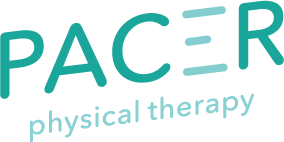Navigating the first few weeks after delivery can be understandably daunting. You’ve been adapting to a new routine, busy with newborn appointments, and implementing the tips from early recovery for c-section or vaginal delivery to keep yourself in good health.
And although you have a 6-week postpartum appointment on your radar, you may still seek more guidance until then.
In this blog, we will cover early postpartum exercise considerations, ergonomics, fueling, and sleep suggestions to support you in feeling confident in movement and caring for your little one.
Exercise Considerations
Aerobic
The American College of Obstetricians and Gynecologists (ACOG) recommends at least 150 minutes of moderate-intensity aerobic activity every week, or about 30 minutes per day for 5 days a week.
To be very clear:
You don’t have to resume this movement goal the day you deliver—listen to your body and honor its healing process.
You can start moving more often once you are feeling ready to walk around again. Some activities that are low risk to engage in in the first few weeks include:
- Walking
- Brisk walking
- Pushing the stroller
- Using the elliptical (with zero percent grade)
Start small: Aim for 10 minutes of continuous movement 3 times a day. Remember: Every movement counts. And it doesn’t have to be done in one go!
Some indicators that you may be moving too intensely include pelvic heaviness, bleeding or spotting, pain, and urinary or fecal leaking.
If you experience any of these symptoms, decrease the intensity or the duration of the movement. If the symptoms persist into the next day, contact your OB/GYN or pelvic health physical therapist (PHPT).
You may begin physical therapy even before you are “cleared” by your doctor, so it is never too early to start to obtain further guidance.
Strength
Believe it or not, there are some low-risk exercises that you can do before your 6-week appointment!
These include doing pelvic floor contractions (Kegels) and deep core activation. The most important thing to remember when doing strengthening exercises is to not hold your breath.
When you meet with a PHPT, you go into more detail regarding when to inhale and exhale with each exercise to optimize connecting movement with breath.
Here’s a video of Dr. Juliana Galante-Wiegman, PT, DPT, PCES, CSCS, of Pacer Physical Therapy, showing how to engage your core safely and effectively after having a baby:
Mobility
A necessary adjunct to strengthening is improving and working on mobility.
During pregnancy, posture changes significantly, which can lead to decreased movement in the ribs, spine, and hips. And that can turn into aches and pains.
Some low-risk exercises to help restore optimal mobility include
- Diaphragmatic breathing
- Pelvic tilts
- Open books
- Cat-cows.
If you are unsure how to do these movements correctly, or which are best for your body, schedule a discovery call with me. We can work together to create a perfectly personalized plan for you starting as soon as week 1 or 2 post delivery!
Here’s a look at postpartum breathing techniques from Dr. Galante-Wiegman:
ERGONOMICS
Lifting
Whether you are bending down to pick up your baby, the carrier, or anything else off of the ground, always bend at the hips and knees instead of your waist and back.
If you are picking up your little one, make sure you hug the baby close to your chest/torso before standing back up. It’s a lot easier to pick something up when it’s at your chest than when it’s an arm’s length away (can’t argue with physics here).
And if you’re going to be picking up your little one often, might as well be efficient about it and minimize your potential injury risk.
Carrying
Speaking of efficiently maneuvering with your baby, carry your newborn at your chest in front of you. You can use both hands or just one arm to support them.
However, if you do find yourself using one arm more than the other, make sure you switch arms often to load each side evenly.
Although not recommended, if you carry your baby at your hip, aim to switch sides every 15-20 minutes.
Feeding
When feeding your little one, bring the baby to you instead of you to the baby. Consider feeding in a side-lying position, in which you and the baby are supported by pillows and the surface you’re lying on.
If you prefer feeding while seated, consider assuming a reclined position, having your feet flat on the floor, and using lots of pillows to support you and your baby.
Let the pillows do the work, not your body. Create your nest of pillows and try stacking a pillow and then a Boppy on top if that feels better for you.
Fueling
Caloric Intake
If you are breastfeeding, you need to consume an additional 330 to 400 calories per day, for a total of approximately 2000-2800 calories.
This will ensure you are properly fueled and have the energy you need to care for your little one. Now is not the time to start restricting calories — your body needs to recover.
Water Intake
You need to increase your water intake to replace the amount of fluid your baby consumes. Since your baby can consume up to one liter per day, aim to drink 16 cups of water daily.
A quick tip to help stay hydrated is to drink one glass of water each time you breastfeed.
Side note: Even if you are not breastfeeding, make sure you are still getting the calories and water your body needs each day.
Plant-Based Diet
If you observe a vegan or vegetarian diet, consult with your OB/GYN or a registered dietician to ensure an adequate intake of vitamin B12, choline, iodine, zinc, and omega-3 from your diet and/or postpartum vitamins.
Additional Questions?
If you have additional questions related to fueling, we recommend scheduling an appointment with a registered dietician specializing in postpartum care. If you’re in the Boston area, we recommend working with Heather Zeman at Back Bay Health or Nicole Farnsworth at Lauren Moretti Nutrition.
Sleep
Can you believe that a newborn sleeps up to 18 hours per day? Seems hard to imagine, but the frequent 2–4-hour long naps add up.
Just as rest is important for your little one, it’s important for you too as a mom!
When?
The best tip to ensure a sufficient amount of sleep is to sleep when the baby does instead of just restricting yourself to resting at night.
This may be challenging, so if you have help, try to ask for assistance with the baby so you can get a snooze in, too.
Rely on Your Partner
Additionally, try sharing the role of nighttime feeds with your partner. If you are breastfeeding, consider pumping earlier in the day so your partner can feed the baby during the night.
Tips to Fall Asleep
If you are struggling to fall asleep, try some relaxation techniques, such as 4-7-8 breathing or vagus nerve stimulation, to downregulate your sympathetic nervous system and get you into a more restful state.
It’s YOUR Journey to Postpartum Care
Everyone’s postpartum journey and experience will be different. So give yourself the grace to figure things out and take everything one day at a time.
I hope this article gave you helpful information on how to conquer the first few weeks before your postpartum appointment. If you have any follow-up questions or if you are ready to meet with a pelvic health physical therapist (PHPT), please reach out.
I would love to hear about your birth story and help address your individual needs to get you feeling confident and strong. Schedule a discovery call with me today!
You got this!
Vera
Resources:






